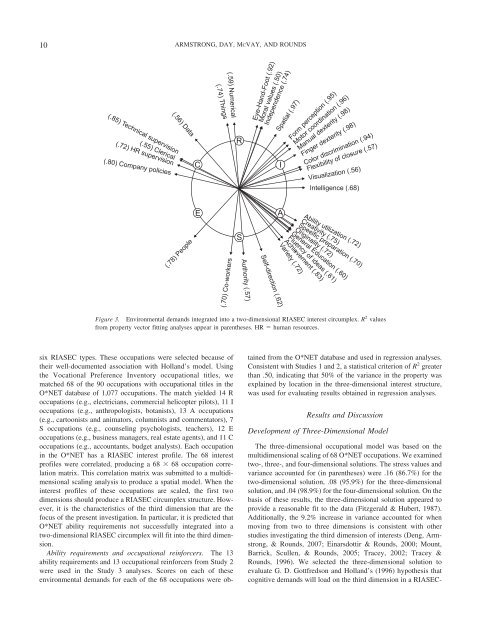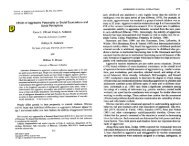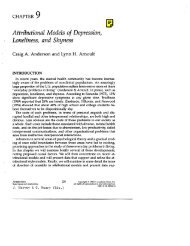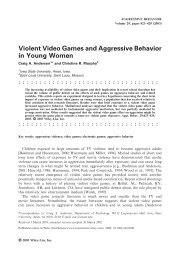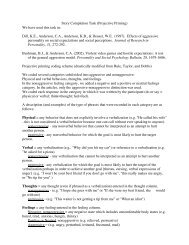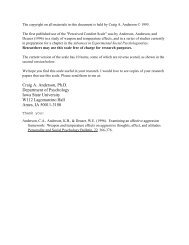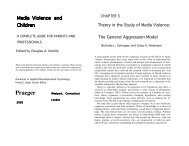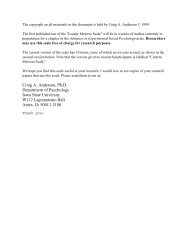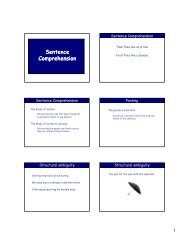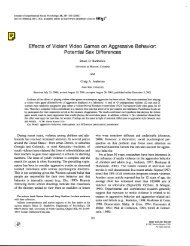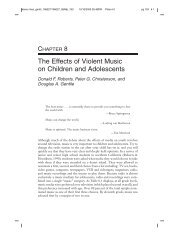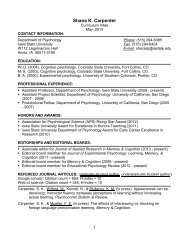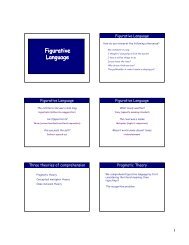Holland's RIASEC Model as an Integrative Framework for Individual ...
Holland's RIASEC Model as an Integrative Framework for Individual ...
Holland's RIASEC Model as an Integrative Framework for Individual ...
Create successful ePaper yourself
Turn your PDF publications into a flip-book with our unique Google optimized e-Paper software.
10 ARMSTRONG, DAY, MCVAY, AND ROUNDS<br />
Figure 3. Environmental dem<strong>an</strong>ds integrated into a two-dimensional <strong>RIASEC</strong> interest circumplex. R 2 values<br />
from property vector fitting <strong>an</strong>alyses appear in parentheses. HR hum<strong>an</strong> resources.<br />
six <strong>RIASEC</strong> types. These occupations were selected because of<br />
their well-documented <strong>as</strong>sociation with Holl<strong>an</strong>d’s model. Using<br />
the Vocational Preference Inventory occupational titles, we<br />
matched 68 of the 90 occupations with occupational titles in the<br />
O*NET datab<strong>as</strong>e of 1,077 occupations. The match yielded 14 R<br />
occupations (e.g., electrici<strong>an</strong>s, commercial helicopter pilots), 11 I<br />
occupations (e.g., <strong>an</strong>thropologists, bot<strong>an</strong>ists), 13 A occupations<br />
(e.g., cartoonists <strong>an</strong>d <strong>an</strong>imators, columnists <strong>an</strong>d commentators), 7<br />
S occupations (e.g., counseling psychologists, teachers), 12 E<br />
occupations (e.g., business m<strong>an</strong>agers, real estate agents), <strong>an</strong>d 11 C<br />
occupations (e.g., account<strong>an</strong>ts, budget <strong>an</strong>alysts). Each occupation<br />
in the O*NET h<strong>as</strong> a <strong>RIASEC</strong> interest profile. The 68 interest<br />
profiles were correlated, producing a 68 68 occupation correlation<br />
matrix. This correlation matrix w<strong>as</strong> submitted to a multidimensional<br />
scaling <strong>an</strong>alysis to produce a spatial model. When the<br />
interest profiles of these occupations are scaled, the first two<br />
dimensions should produce a <strong>RIASEC</strong> circumplex structure. However,<br />
it is the characteristics of the third dimension that are the<br />
focus of the present investigation. In particular, it is predicted that<br />
O*NET ability requirements not successfully integrated into a<br />
two-dimensional <strong>RIASEC</strong> circumplex will fit into the third dimension.<br />
Ability requirements <strong>an</strong>d occupational rein<strong>for</strong>cers. The 13<br />
ability requirements <strong>an</strong>d 13 occupational rein<strong>for</strong>cers from Study 2<br />
were used in the Study 3 <strong>an</strong>alyses. Scores on each of these<br />
environmental dem<strong>an</strong>ds <strong>for</strong> each of the 68 occupations were obtained<br />
from the O*NET datab<strong>as</strong>e <strong>an</strong>d used in regression <strong>an</strong>alyses.<br />
Consistent with Studies 1 <strong>an</strong>d 2, a statistical criterion of R 2 greater<br />
th<strong>an</strong> .50, indicating that 50% of the vari<strong>an</strong>ce in the property w<strong>as</strong><br />
explained by location in the three-dimensional interest structure,<br />
w<strong>as</strong> used <strong>for</strong> evaluating results obtained in regression <strong>an</strong>alyses.<br />
Results <strong>an</strong>d Discussion<br />
Development of Three-Dimensional <strong>Model</strong><br />
The three-dimensional occupational model w<strong>as</strong> b<strong>as</strong>ed on the<br />
multidimensional scaling of 68 O*NET occupations. We examined<br />
two-, three-, <strong>an</strong>d four-dimensional solutions. The stress values <strong>an</strong>d<br />
vari<strong>an</strong>ce accounted <strong>for</strong> (in parentheses) were .16 (86.7%) <strong>for</strong> the<br />
two-dimensional solution, .08 (95.9%) <strong>for</strong> the three-dimensional<br />
solution, <strong>an</strong>d .04 (98.9%) <strong>for</strong> the four-dimensional solution. On the<br />
b<strong>as</strong>is of these results, the three-dimensional solution appeared to<br />
provide a re<strong>as</strong>onable fit to the data (Fitzgerald & Hubert, 1987).<br />
Additionally, the 9.2% incre<strong>as</strong>e in vari<strong>an</strong>ce accounted <strong>for</strong> when<br />
moving from two to three dimensions is consistent with other<br />
studies investigating the third dimension of interests (Deng, Armstrong,<br />
& Rounds, 2007; Einarsdottir & Rounds, 2000; Mount,<br />
Barrick, Scullen, & Rounds, 2005; Tracey, 2002; Tracey &<br />
Rounds, 1996). We selected the three-dimensional solution to<br />
evaluate G. D. Gottfredson <strong>an</strong>d Holl<strong>an</strong>d’s (1996) hypothesis that<br />
cognitive dem<strong>an</strong>ds will load on the third dimension in a <strong>RIASEC</strong>-


